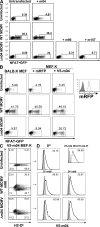Ly49P recognition of cytomegalovirus-infected cells expressing H2-Dk and CMV-encoded m04 correlates with the NK cell antiviral response
- PMID: 19255146
- PMCID: PMC2699136
- DOI: 10.1084/jem.20080954
Ly49P recognition of cytomegalovirus-infected cells expressing H2-Dk and CMV-encoded m04 correlates with the NK cell antiviral response
Abstract
Natural killer (NK) cells are crucial in resistance to certain viral infections, but the mechanisms used to recognize infected cells remain largely unknown. Here, we show that the activating Ly49P receptor recognizes cells infected with mouse cytomegalovirus (MCMV) by a process that requires the presence of H2-D(k) and the MCMV m04 protein. Using H2 chimeras between H2-D(b) and -D(k), we demonstrate that the H2-D(k) peptide-binding platform is required for Ly49P recognition. We identified m04 as a viral component necessary for recognition using a panel of MCMV-deletion mutant viruses and complementation of m04-deletion mutant (Deltam04) virus infection. MA/My mice, which express Ly49P and H2-D(k), are resistant to MCMV; however, infection with Deltam04 MCMV abrogates resistance. Depletion of NK cells in MA/My mice abrogates their resistance to wild-type MCMV infection, but does not significantly affect viral titers in mice infected with Deltam04 virus, implicating NK cells in host protection through m04-dependent recognition. These findings reveal a novel mechanism of major histocompatibility complex class I-restricted recognition of virally infected cells by an activating NK cell receptor.
Figures





References
-
- Biron C.A., Byron K.S., Sullivan J.L. 1989. Severe herpesvirus infections in an adolescent without natural killer cells.N. Engl. J. Med. 320:1731–1735 - PubMed
Publication types
MeSH terms
Substances
Grants and funding
LinkOut - more resources
Full Text Sources
Other Literature Sources

